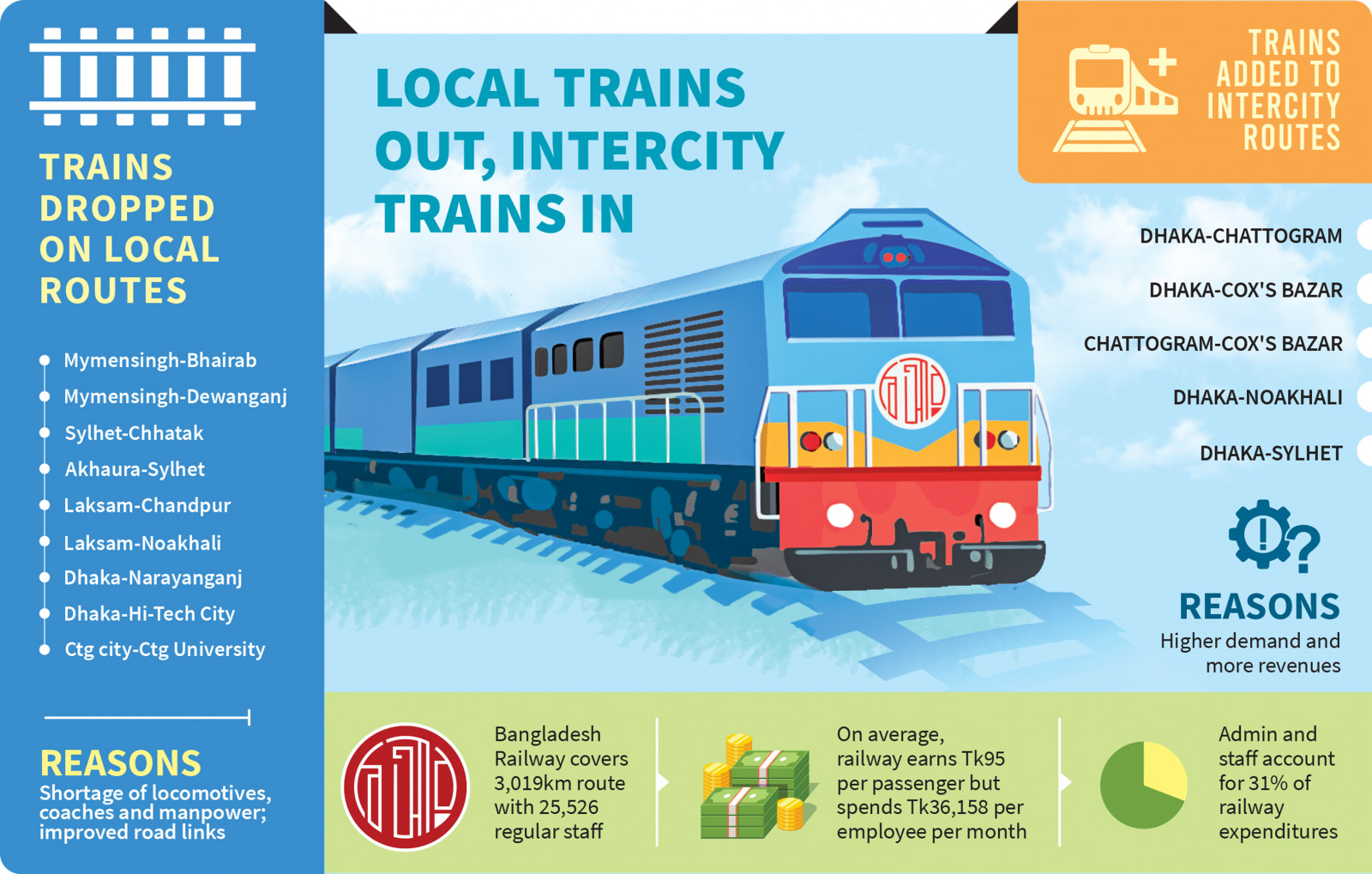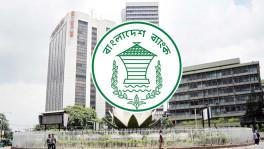Local trains keep closing. Will it make railways viable?
Punctuality, train delays and cancellation are main issues of great concern to train users

With new routes and tracks being added, the Bangladesh Railway has now directed its limited resources to intercity trains, dropping commuter and local trains mostly used by low-income and short-distance travellers.
Bangladesh Railway's new work timetable, effective from 1 December last year, shows 13 pairs of local, mail, and commuter, including some much-used shuttle trains from Dhaka and Chattogram, have been withdrawn from service.
On the other hand, the railway plans to introduce at least six pairs of intercity trains on the newly-opened Cox's Bazar routes as well as between Dhaka and Chattogram.
Railway officials cite shortage of locomotives, coaches and manpower for dropping short routes – a step which communication experts and rights activists say will disrupt low-cost local transportation of people and goods and hit the supply chain between farms and business centres.
The authorities will consider putting those trains back to service once enough locomotives are procured and manpower recruited, Bangladesh Railway Director General Md Quamrul Ahsan told The Business Standard, without specifying a time frame.
13 pairs of local train dropped
New time-table shows two pairs of trains on the Mymensingh-Bhairab route, one pair between Mymensingh and Dewanganj, two pairs on Sylhet-Chhatak route have been withdrawn. The list includes Kushiara Express on Akhaura-Sylhet route, and two commuter trains from Laksam to Chandpur and Noakhali.
The frequency of commuter train service between Dhaka and Narayanganj has been brought down to 8 round trips from the previous 16.
The Chattogram University shuttle train service to and from Chattogram rail station has been very useful for students. Its frequency has been reduced along with local train trips between Dhaka and Kaliakoir.
Trains on list, but not on tracks
The Isha Khan Express on Dhaka-Mymensingh route, which was important for people from Kishoreganj, Netrokona, Narsingdi, and Gazipur to travel to Mymensingh and Dhaka, has been closed since March 2012. The train, however, is still on the list of operations.
The Jalalabad Express mail train, with about 1,300 seats, has been closed since February 2020. People from Moulvibazar, Habiganj, Brahmanbaria, Cumilla, and Feni could travel to the two divisional cities of Chattogram and Sylhet at a low cost by stopping at 71 stations along the way.
Like the Isha Khan Express and the Jalalabad Express, several mail, commuter, and local trains have been in operation only on paper for a long time.
Intercity routes getting more trains
A review of the new timetable shows that Bangladesh Railway plans to launch at least six new intercity trains, subject to availability of new locomotives and coaches.
Of these, schedules have been announced for one pair of trains on the Dhaka-Chattogram route, one pair on the Dhaka-Cox's Bazar route, and two pairs on the Chattogram-Cox's Bazar route.
In addition, names of one pair of non-stop trains — the "Subarnachar Express" on the Dhaka-Noakhali route and the "Tanguar Express" on the Dhaka-Sylhet route — have also been finalised, subject to availability of rolling stock.
In the fiscal 2019-20, 248 of the total 350 trains in the Bangladesh Railway fleet operated as commuter, mail, and local trains. This means that about 30% of the total trains were intercity.
Over time, the total number of trains has fallen to 321, but during this time the number of intercity trains has increased by six. During this time, the number of local trains has decreased by 36.
Washing hands off short routes?
The railway has long been in the mood of getting rid of short-distance branch lines which it found not viable because of poor ticket sales and development of local road communication.
Railway's information book shows in 35 years till 2005, train passengers decreased by 42%, although the population of the country has doubled. This is due to a significant change in the travel pattern, it finds.
"This is mainly because more passengers are now using long-haul intercity trains," it says.
Though average distance travelled by individual passengers increased from less than 46km in 1970 to 99km in 2005, people preferred road transports to local trains for shorter distances and opted for intercity trains for long routes, the railway finds.
Analysing passenger trends in short and long routes, the railway's information book reveals that overall passenger traffic in trains has grown only very slightly in 10 years to 2005 (an average of 0.65% per year). It attributed the slow growth mostly to decline in local and branch line passengers.
But compared to this, the intercity passenger traffic grew 3% per year. The loss of passenger traffic along branch lines has been partly due to reduced railway services and closure of many branch lines as well as stiff competition from road transport over short distances, where frequent bus services are available now, it adds.
Punctuality, train delays and cancellation are the three main issues of great concern to train users, the report book says, identifying the average punctuality rate of 60% as annoying to travellers.
Slow speed of train (32km per hour) is another weakness of the rail services, it says, referring to studies that the track conditions in the branch lines are in deplorable condition and cancellation of train service is a usual matter there.
Therefore, increasing punctuality, improved maintenance of coaches, increase of speed, development of timetable, passenger information, and customer services are some of the main concerns, which the Railway Master Plan is going to address, the document says.
Professor Hadiuzzaman of the Civil Engineering Department at Bangladesh University of Engineering and Technology, says if local trains are closed, it will be difficult to develop businesses in rural areas. It will also disrupt the supply of agricultural products to cities at low prices.
Mohammad Mozammel Haque Chowdhury, secretary general of the Bangladesh Passengers Welfare Association, says the government has been providing subsidies to the railway for years in the name of public welfare.
Therefore, he says, the government is depriving the poor of their rights by closing local trains.
Is social cost too heavy for BR?
The Bangladesh Railway covers a length of 3,019km route by 25,526 regular staff, with a ratio of 8.45 for 1 km, which is 17 in India.
The revised master plan calls for 47,703 posts to improve the quality of service.
Indian railway, the world's fourth largest railway system, has 11.76 lakh workforce as of March this year to serve a total route length of 68,100 km.
India's second largest public sector employer abolished over 72,000 posts in recent years, finding those 'non-essential' as new technologies and system upgradation render many manual services redundant.
Under the Railway Recovery Programme (RRP) launched in 1991, Bangladesh Railway also reduced its workforce from 58,000 to 35,000 as it closed a number of revenue-losing branch lines and non-profitable passenger train services.
During the year 2018-2019, net operating ratio of Bangladesh Railway was 216%, meaning that its total expenses were 216% of total earnings. Administration and staff account for 31% of railway expenditures.
On average, the railway earns Tk95 per passenger, but spends Tk36,158 per employee per month.
In its 2019 information book, railway argues how discharging many social obligations, which are not commercially viable, put Bangladesh Railway under certain cost burdens namely "social cost".
Carrying passengers at lower prices than cost of services and operating uneconomic branch lines are among the "social obligations," it cited.
However, it claims, Bangladesh Railway has been able to cover its operating expenses as it is being compensated for some of its "'Public Service Obligations (PSO)"' that replaced the open-ended subsidy.
Can local and commuter trains be viable?
Railways around the globe value the need of local trains and rural stations in service, while taking care of revenues.
It was a global media headline when a Japanese railway company waited for months in 2016 to close its service at a remote rail station, Kami-Shirataki, until a schoolgirl completed her schooling. The station was built 60 years ago to take local kids to school and the girl was the only passenger the day the station was abandoned.
India's 50-year-old Dayalpur railway station was closed in 2016 for poor revenue. Following petitions from local people, it was reopened last year with the condition that a minimum number of tickets must be sold per day. Villagers created a monthly fund to make up for any drop in sales to not let the station close again.
Experts say Bangladesh Railway needs to take a proactive approach to operate its local and commuter trains through attracting more passengers with improved quality of service.
Public transportation expert Prof Shamul Haque says that Bangladesh Railway has been focusing on expanding its network and launching new services, while neglecting the established, tested, and sustainable system of short-distance passenger transportation.



 Keep updated, follow The Business Standard's Google news channel
Keep updated, follow The Business Standard's Google news channel
















